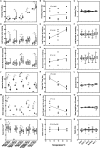The Effect of Ambient Temperature on Brachypodium distachyon Development
- PMID: 31497030
- PMCID: PMC6712961
- DOI: 10.3389/fpls.2019.01011
The Effect of Ambient Temperature on Brachypodium distachyon Development
Abstract
Due to climate change, the effect of temperature on crops has become a global concern. It has been reported that minor changes in temperature can cause large decreases in crop yield. While not a crop, the model Brachypodium distachyon can help to efficiently investigate ambient temperature responses of temperate grasses, which include wheat and barley. Here, we use different accessions to explore the effect of ambient temperature on Brachypodium phenology. We recorded leaf initiation, heading time, leaf and branch number at heading, seed set time, seed weight, seed size, seed dormancy, and seed germination at different temperatures. We found that warmer temperatures promote leaf initiation so that leaf number at heading is positively correlated to temperature. Heading time is not correlated to temperature but accessions show an optimal temperature at which heading is earliest. Cool temperatures prolong seed maturation which increases seed weight. The progeny seeds of plants grown at these cool ambient temperatures show stronger dormancy, while imbibition of seeds at low temperature improves germination. Among all developmental stages, it is the duration of seed maturation that is most sensitive to temperature. The results we found reveal that temperature responses in Brachypodium are highly conserved with temperate cereals, which makes Brachypodium a good model to explore temperature responsive pathways in temperate grasses.
Keywords: ambient temperature; heading time; seed dormancy; seed maturation time; seed weight.
Figures





Similar articles
-
Grain dormancy and light quality effects on germination in the model grass Brachypodium distachyon.New Phytol. 2012 Jan;193(2):376-86. doi: 10.1111/j.1469-8137.2011.03938.x. Epub 2011 Oct 31. New Phytol. 2012. PMID: 22039925
-
Seed dormancy and germination changes of snowbed species under climate warming: the role of pre- and post-dispersal temperatures.Ann Bot. 2016 Sep;118(3):529-39. doi: 10.1093/aob/mcw125. Epub 2016 Jul 6. Ann Bot. 2016. PMID: 27390354 Free PMC article.
-
Thermal stress effects on grain yield in Brachypodium distachyon occur via H2A.Z-nucleosomes.Genome Biol. 2013 Jun 25;14(6):R65. doi: 10.1186/gb-2013-14-6-r65. Genome Biol. 2013. PMID: 23800039 Free PMC article.
-
Mechanisms of Maturation and Germination in Crop Seeds Exposed to Environmental Stresses with a Focus on Nutrients, Water Status, and Reactive Oxygen Species.Adv Exp Med Biol. 2018;1081:233-257. doi: 10.1007/978-981-13-1244-1_13. Adv Exp Med Biol. 2018. PMID: 30288713 Review.
-
Seed germination and vigor: ensuring crop sustainability in a changing climate.Heredity (Edinb). 2022 Jun;128(6):450-459. doi: 10.1038/s41437-022-00497-2. Epub 2022 Jan 10. Heredity (Edinb). 2022. PMID: 35013549 Free PMC article. Review.
Cited by
-
The increasing diversity and complexity of the RNA-binding protein repertoire in plants.Proc Biol Sci. 2020 Sep 30;287(1935):20201397. doi: 10.1098/rspb.2020.1397. Epub 2020 Sep 23. Proc Biol Sci. 2020. PMID: 32962543 Free PMC article.
-
Molecular Links between Flowering and Abiotic Stress Response: A Focus on Poaceae.Plants (Basel). 2023 Jan 10;12(2):331. doi: 10.3390/plants12020331. Plants (Basel). 2023. PMID: 36679044 Free PMC article. Review.
-
Temporal Control of Seed Development in Dicots: Molecular Bases, Ecological Impact and Possible Evolutionary Ramifications.Int J Mol Sci. 2021 Aug 26;22(17):9252. doi: 10.3390/ijms22179252. Int J Mol Sci. 2021. PMID: 34502157 Free PMC article. Review.
-
Treatment Analogous to Seasonal Change Demonstrates the Integration of Cold Responses in Brachypodium distachyon.Plant Physiol. 2020 Feb;182(2):1022-1038. doi: 10.1104/pp.19.01195. Epub 2019 Dec 16. Plant Physiol. 2020. PMID: 31843801 Free PMC article.
-
EARLY FLOWERING 3 and Photoperiod Sensing in Brachypodium distachyon.Front Plant Sci. 2022 Jan 6;12:769194. doi: 10.3389/fpls.2021.769194. eCollection 2021. Front Plant Sci. 2022. PMID: 35069625 Free PMC article.
References
-
- Al-Mudaris M. (1998). Notes on various parameters recording the speed of seed germination. Der Tropenlandwirt 99 147–154.
-
- Al–Khatib K., Paulsen G. M. (1984). Mode of high temperature injury to wheat during grain development. Physiol. Plant. 61 363–368. 10.1111/j.1399-3054.1984.tb06341.x - DOI
-
- Angus J. F., Mackenzie D., Morton R., Schafer C. A. (1981). Phasic development in field crops II. thermal and photoperiodic responses of spring wheat. Flied Crop Res. 4 269–283. 10.1016/0378-4290(81)90078-2 - DOI
-
- Bahuguna D. K., Kumar V., Singh Y. P., Kumar N., Raju, Nishant, et al. (2014). Effect of phyllochron on leaf emergence stage in barley, wheat and rye. Int. J. Basic Appl. Biol. 2 121–126.
LinkOut - more resources
Full Text Sources

